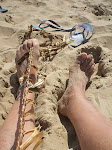Last night I burned most of the hundred plus willow experiments
I made for my research at the RCA and it was good, it warmed the room
for a short period of time and felt like a little act of revolt against the
stuff.
Willow has been
an important part of my life; I have grown it, made lots of things with it and
devoted four years of my life to researching it. But, for some time now I have been jokingly
saying to friends that I will set up a facebook page called
Anything But Willow !
Of course, I mean no disrespect to the plant or the many friends and colleagues who make
lovely things with willow, so why do I feel like this? Because it seems to me
that in parts of Northern Europe, at least, we have
become infatuated with it to the exclusion of lots of other wonderful natural
materials and that by not using these other materials
we are losing the knowledge of how to work with them.
A quick analysis of the
workshops and courses on offer at the moment by the English, Scottish and
Danish Basketmakers associations shows that willow predominates. It also
shows that there is very little instruction on offer for its cultivation . In the latest Basketmakers Association newsletter, however, there are just
over a hundred courses on offer of which more than 90 include weaving with
willow.
It is easy to buy a bundle of commercially
grown willow. It is a good way for people to learn how to make a basket without
having to deal with the often difficult and
time consuming, yet very important part of basket making, which is gathering and
preparing the material. But, it has always
seemed to me that if you don’t enjoy preparing the materials
you probably won’t ever really like making
baskets. The materials need preparation,
whatever they are, and that preparation can often take longer than making the
basket so you really need to enjoy that part
of the process as well as the weaving bit.
 |
| gathering wild oats |
Basket making used to be done by the people who needed the
basketry for their day to day existence. They used whatever material
they had in their vicinity and managed it sustainably, knowing that if they
didn’t there wouldn’t be any of it there next year. They knew everything about
the growth cycle, how and when to harvest it and how to prepare it for use. Now
we can order a bolt of willow on line without really
knowing anything about how it became this beautiful, even bundle of rods and the
various processes that have to be undertaken at precise times of the year for
it to arrive on our doorstep whenever we want it. It's a bit like buying strawberries from a supermarket in
December that have been flown in from the southern hemisphere and willow can
have an equally heavy ecological footprint as that of the strawberries, if it hasn’t been grown organically.
There is an astonishing richness of natural
materials available to us in Northern
Europe to make baskets with. But why are there so few classes in using
straw, wild clematis, dock stalks, hazel, ash or
some of the myriad varieties of shrubs, trees, rushes and grasses that are
everywhere in our countryside for us to use for free? Not forgetting the even
more varied range of materials that can be
‘harvested’ for free in our cities or on our beaches.
The classes aren’t there because there are only a few people capable of teaching us how to use these materials. Much of this knowledge has not been handed down and is now lost. So it’s a chicken and egg situation, there may be lots of people who want to learn how to make baskets but the only courses they can go on are for willow. So that is what they learn, often unaware that there are many other materials that you can make baskets with.
The classes aren’t there because there are only a few people capable of teaching us how to use these materials. Much of this knowledge has not been handed down and is now lost. So it’s a chicken and egg situation, there may be lots of people who want to learn how to make baskets but the only courses they can go on are for willow. So that is what they learn, often unaware that there are many other materials that you can make baskets with.
 |
| wild clematis |
However, something has happened recently that may alter
things. The French magazine Le Lien Creatif has arrived on the scene. This
magazine devoted to basket making is turning into a superb resource for learning
about all the other natural
materials there are out there that can be used
for basket making. Fortunately in France
there are still some elderly makers who specialise
in materials other than willow and Bernard
Bertrand, the editor who is the hero in all this, is
doing his best to track them all down to
record and publish as much of their precious knowledge as he can. It’s a Herculean task
that he has taken on, but worth it because each magazine is richer than the previous one. Even
if you don’t read French there are many step by step instructions for material
gathering and preparation as well as basket construction. Bernard is hoping to
produce an English version of the magazine either on line or in print. So, if
anyone reading this is in the publishing business and is interested in helping
to get an English version off the ground please contact Bernard at the
magazine. Hopefully if enough people get to see Le Lien Creatif some might get
excited by these other forgotten materials and
in a few years time there will be many more classes using other materials.





